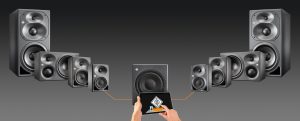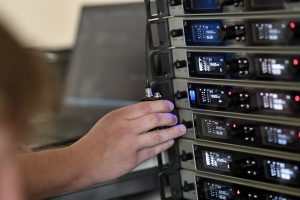NAMM 2020: Sennheiser, Neumann Flaunt DSP Power, Digital 6000 Technologies
Story Highlights
In the face of the ever-shrinking UHF spectrum available for the program-making and special events (PMSE) sector, Sennheiser is launching a “Link Density Mode” for its Digital 6000 wireless microphone series. In addition, Neumann has greatly enhanced the features of the KH 750 DSP subwoofer, which was launched in 2019, with the release of the latest version of the Neumann.Control iPad app (version 3.0).
 DSP Power
DSP Power
The “Guided Alignment” and “Manual Alignment” functions that allow for easy acoustic adjustment to the room now not only work with KH 80 DSP near-field monitors, but also in stereo setups with all other Neumann KH Line monitors (KH 120/310/420). Simply connect these monitors to the stereo outputs of the KH 750 DSP subwoofer and, in conjunction with the iPad® app, they can now also benefit from its DSP power. In this way, the KH 750 DSP can now serve as the intelligent control center of every Neumann stereo setup.
“Guided Alignment” is a patented wizard where you are asked simple questions about the room and the loudspeaker/subwoofer position and the app adjusts the response of each loudspeaker/subwoofer accordingly.
With “Manual Alignment” expert users have complete freedom to adjust an 8-band fully parametric equalizer, levels and the time-of-flight delay in each loudspeaker or subwoofer as they wish. “Manual Alignment” can also be used to edit Guided Alignments in a more detailed way.
Furthermore, this configuration offers the following advantages:
- Individual X-Over optimization between the subwoofer and the connected Neumann monitors, depending on the monitor model used.
- DSP-based phase linearization of the connected analog Neumann studio monitors for an even more transparent sound image.
- Use of the digital inputs (S/P-DIF and AES3) of the subwoofer for the entire system.
- Lip sync delay for the complete setup.
 Digital 6000
Digital 6000
The new Link Density (LD) Mode significantly increases the number of links that can be operated in congested RF environments. While the standard Long Range Mode of Digital 6000 operates with a 400 kHz channel spacing to ensure best audio and RF performance, the LD Mode uses half of the spacing, i.e. 200 kHz. This means that up to 40 links can be accommodated in an 8-MHz TV channel in Europe, and up to 30 links in the smaller 6-MHz TV channel in the USA.
“Virtually everywhere the world over, production companies, theatres and touring artists and their engineers have lost more UHF spectrum than can be compensated for,” explained Tom Vollmers, Manager for the Professional Portfolio, Sennheiser. “With the Link Density Mode for Digital 6000, we are providing greater leeway to PMSE professionals while continuing our joint efforts to secure frequency spectrum that is so urgently needed for productions.”
Giving engineers a choice
Behind the LD Mode is the new Sennheiser Performance Audio Codec (SePAC) which has been designed by Sennheiser’s developers to strike a new balance between channel count on one hand and RF and audio performance on the other.
“The LD Mode provides productions with a choice where there simply was none before,” said Vollmers. “They are now able to increase the number of channels by accepting slight trade-offs in the audio frequency response and RF range. This can be a good solution for applications that only have very limited spectrum at their disposal.”
Codec comparison and firmware update information
The new LD Mode will be made available free of charge via a firmware update from January 16, 2020 at www.sennheiser.com/download. It can be used with all existing Digital 6000 systems in the market except for the EK 6042 camera receiver, which will not support LD Mode.
“For those visiting NAMM, we will have the new firmware version at the booth and will be happy to provide you with a demonstration,” added Vollmers.
